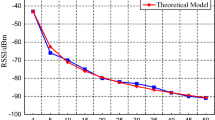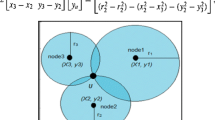Abstract
Distance estimation between sensor nodes is crucial to localization and object tracking in a wireless sensor network. The received signal strength indicator is widely used for wireless distance estimation, because of its advantages, including availability, low cost, flexibility, and so on. As is well known, RSSI measurement values are extremely susceptible to the surroundings, resulting in uncertain distance estimations. Without confidential information, the distance estimation results could not provide valuable priori information for follow-up processing methods and applications, such as localization, navigation, and guidance. In this paper, we propose a new uncertainty analysis method for RSSI-based distance estimation (UAM-RDE) to study the uncertainty propagation in RSSI-based distance estimations. In UAM-RDE, we explore the uncertainty propagation mechanism from the input to the output of the RSSI-based distance estimation, including uncertainty factor analysis, sensitivity analysis, propagation, and synthesis of uncertainty. The simulations and experimental results validate and demonstrate the feasibility of UAM-RDE.























Similar content being viewed by others
Abbreviations
- UAM-RDE:
-
Uncertainty analysis method for RSSI-based distance estimation
- WSNs:
-
Wireless sensor networks
- RSSI:
-
Received signal strength indicator
- TOA:
-
Time of arrival
- TDOA:
-
Time difference of arrival
- AOA:
-
Angle of arrival
References
Luo Q, Peng Y, Li J, Peng X (2016) RSSI-based localization through uncertain data mapping for wireless sensor networks. IEEE Sensors J 16(9):3155–3162
Franco DC, Prorok A, Atanasov N, Kempke B, Dutta P et al (2017) Calibration-free network localization using non-line-of-sight ultra-wideband measurements. In: Proceedings of 2017 16th ACM/IEEE international conference on information processing in sensor networks, IPSN 2017, pp 235–246
Luo QH, Peng Y, Peng XY et al (2014) Uncertain data clustering-based distance estimation in wireless sensor networks. Sensors 14(4):6584–6605
Luo QH, Yan XZ, Li JB et al (2014) DDEUDSC: a dynamic distance estimation using uncertain data stream clustering in mobile wireless sensor networks. Measurement 55(40):423–433
Baccour N, Koubâa A, Youssef H, Jamâa MB, Do Rosário D et al (2010) F-LQE: a fuzzy link quality estimator for wireless sensor networks. In: Proceedings of 7th European workshop on wireless sensor networks, Coimbra, pp 240–255
Sylvain L, Christophe C, Bruno F (2017) Feasibility of WiFi site-survey using crowdsourced data. In: Proceedings of latent variable analysis and signal separation—13th international conference, LVA/ICA 2017P, Grenoble, pp 479–488
Shang Y, Ruml W, Zhang Y, Fromherz M (2003) Localization from mere connectivity. In: Proceedings of ACM MobiHoc’2003, Annapolis, MD, USA, pp 201–212
Li Z, Trapp W, Zhang Y, Nath B (2005) Robust statistical methods for securing wireless in sensor networks. In: Proceedings of the 4th international symposium on information processing in sensor networks, Piscataway, NJ, pp 91–98
Fang Z, Zhao Z, Guo P, Zhang Y (2007) Analysis of distance measurement based on RSSI. Chin J Sens Actuators 20:2526–2530
Kung H, Lin C, Lin T, Vlah D (2009) Localization with snap-inducing shaped residuals (SISR): coping with errors in measurement. In: Proceedings of ACM MobiCom’09, Beijing, China, pp 333–334
Xi W, He Y, et al. (2010) Locating sensor in the wild: pursuit of ranging quality. In: Proceedings of SenSys’10, Zurich, Switzerland, pp 295–308
Lee TY, Jeon SY, Han JH et al (2016) A simplified technique for distance and velocity measurements of multiple moving objects using a linear frequency modulated signal. IEEE Sensors J 16(15):5912–5920
Bahl P, Padmanabhan VN (2000) RADAR: an in-building rf-based user location and tracking system. In: Proceedings of IEEE INFOCOM 2000, Tel-Aviv, Israel
Ji Y, Biaz S, Pandey S, Agrawal P (2006) ARIADNE: a dynamic indoor signal map construction and localization system. In: Proceedings of ACM MobiSys’06, Uppsala, Sweden, pp 151–164
Peng Y, Luo QH, Peng XY (2012) WSN localization method using interval data clustering. Acta Automatica Sinica 38(7):1190–1199
Kumar P, Reddy L, Varma S (2009) Distance measurement and error estimation scheme for RSSI based localization in wireless sensor networks. In Proceeding of IEEE conference on wireless communication and sensor networks (WCSN), Allahabad, Indian, pp 80–83
Moravek P, Komosny D, Simek M et al (2013) Investigation of radio channel uncertainty in distance estimation in wireless sensor networks. Telecommun Syst 52(3):1549–1558
Wei YL, Park JH, Qiu JB, Jung HY (2018) Reliable output feedback control for piecewise affine systems with markov-type sensor failure. IEEE Trans Circuits Syst II Express Br 65(7):913–917
Wei YL, Qiu JB, Karimi HR, Ji WQ (2018) A novel memory filtering design for semi-markovian jump time-delay systems. IEEE Trans Syst Man Cybern Syst 48(12):2229–2241
Patwari N, Ash JN, Kyperountas S, Hero AO, Moses RL, Correal NS (2005) Locating the nodes: cooperative localization in wireless sensor networks. IEEE Signal Process Mag 22(4):54–69
Acknowledgements
This work is partly supported by the National Natural Science Foundation of China (61671174, 61601142, and 51909039), the Natural Science Foundation of Shandong Province of China (ZR2015FM027, ZR2014FM023), Weihai Research Program of Science and Technology, the key lab of Weihai, the engineering center of Shandong province, the Laboratory of Satellite Navigation System and Equipment Technology (EX166840037, EX166840044), the Guangxi Key Laboratory of Automatic Detecting Technology and Instruments (YQ14205, YQ15203), the Natural Scientific Research Innovation Foundation of the Harbin Institute of Technology (HIT.NSRIF.2015122, HIT.NSRIF.201721), the Space Science and Technology Foundation (2017-HT-HG-16), and the Discipline Construction Guiding Foundation in Harbin Institute of Technology (Weihai) (WH20150211).
Author information
Authors and Affiliations
Corresponding authors
Ethics declarations
Conflicts of interest
The authors declare that they have no conflict of interest.
Additional information
Publisher's Note
Springer Nature remains neutral with regard to jurisdictional claims in published maps and institutional affiliations.
Rights and permissions
About this article
Cite this article
Yan, X., Zhou, P., Luo, Q. et al. UAM-RDE: an uncertainty analysis method for RSSI-based distance estimation in wireless sensor networks. Neural Comput & Applic 32, 13701–13714 (2020). https://doi.org/10.1007/s00521-020-04777-y
Received:
Accepted:
Published:
Issue Date:
DOI: https://doi.org/10.1007/s00521-020-04777-y




